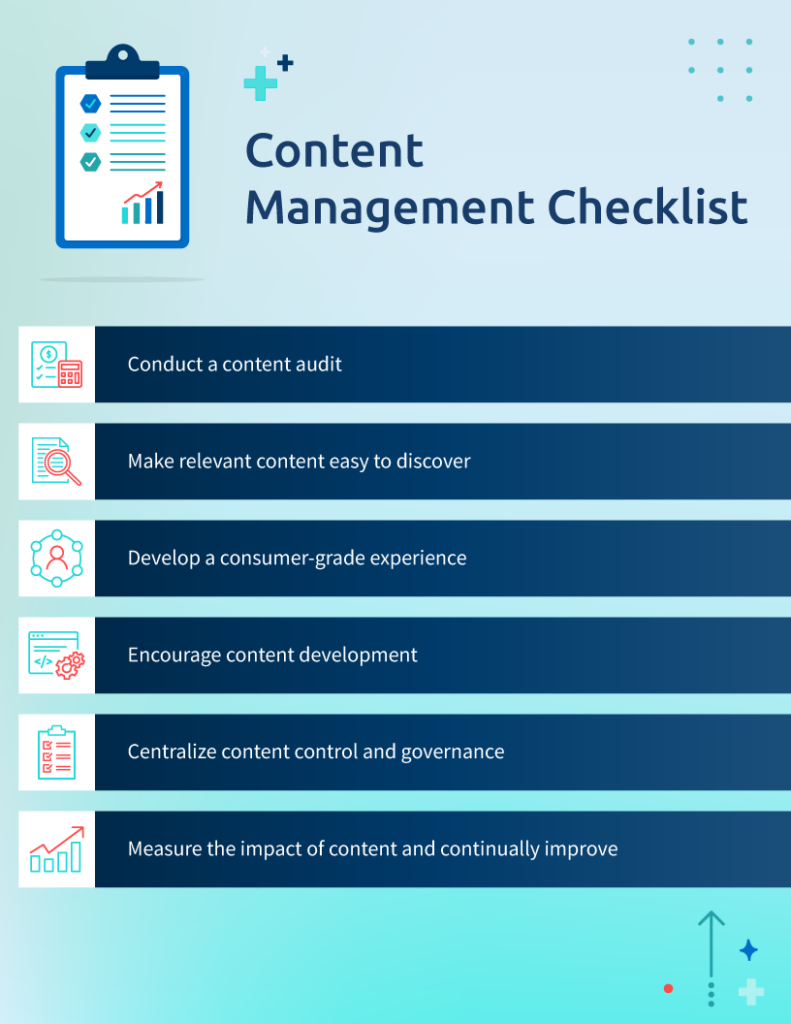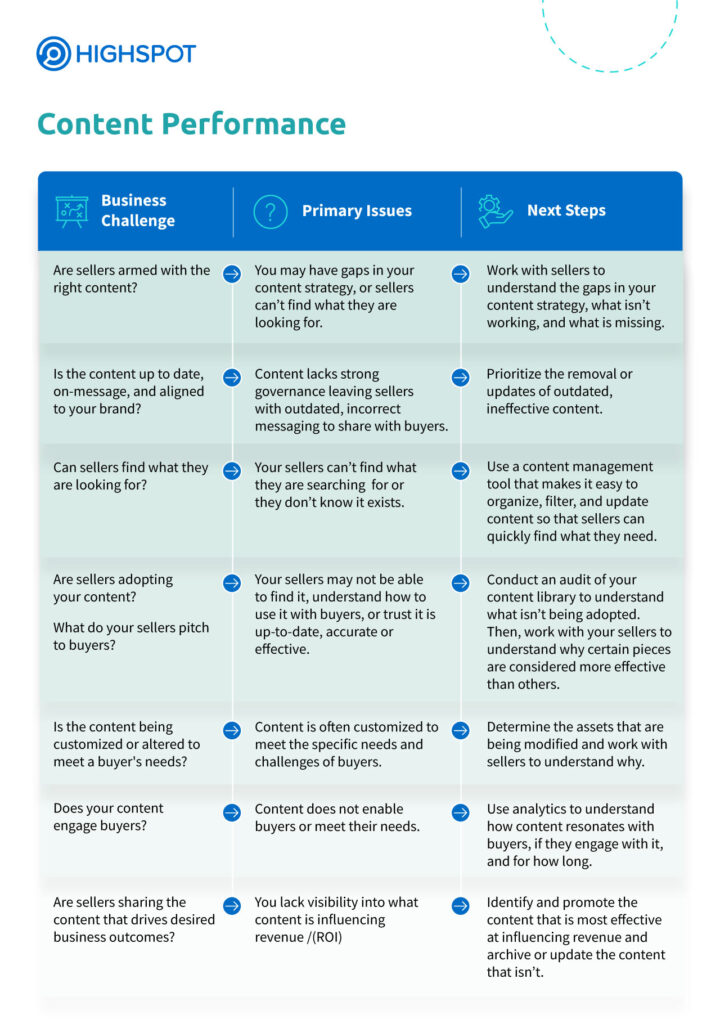Sales content analytics is a game-changing approach that empowers businesses to not only understand the effectiveness of their sales content but also to propel their sales strategies to new heights.
In this blog post, we delve into sales content analytics, exploring its impact on modern sales techniques. We’ll uncover how this approach can be the key to optimizing conversions, supercharging revenue, and fostering lasting customer relationships.
Here, you will navigate the intricacies, benefits, and strategies surrounding sales content analytics, and discover how you can leverage this to streamline sales content creation and stay ahead in today’s competitive marketplace.
- What is Sales Content Analytics?
- Why Sales Content Analytics Matter?
- Ways You Can Leverage Sales Content Management Systems
- Top Sales Content Analytics to Track
- How Often Should You Audit Your Content?
- How to Measure the Effectiveness of Your Sales Content
What is Sales Content Analytics?
Sales content analytics is the practice of analyzing and evaluating the performance and impact of various types of content used throughout the sales process. This can include analyzing the effectiveness of sales collateral, presentations, emails, videos, case studies, whitepapers, blog posts, and any other content that is shared with potential or existing customers during the sales journey.
The goal of sales content analytics is to gain insights into how different types of content contribute to the sales pipeline, customer engagement, and ultimately, revenue generation. By collecting and analyzing data related to content consumption, interaction, and conversion, businesses can make data-driven decisions to optimize their content strategy and enhance their sales efforts.
Why Does Sales Content Analytics Matter?
- Precision in Messaging: Sales content analytics provides a data-driven lens into which messages, themes, and narratives resonate most effectively with your target audience. Say goodbye to guesswork and hello to precision in crafting the right content that speaks directly to your customers’ pain points and aspirations.
- Tailored Customer Engagement: By analyzing in real-time how prospects interact with your content, you can gain insights into their preferences and engagement patterns. This knowledge allows you to tailor your approach, providing personalized content experiences that nurture leads, drive conversions, and close deals.
- Optimized Content Strategy: Unveil your best content pieces that consistently drive results. Armed with this knowledge, you can refine your content strategy, focusing on producing sales content and presentations that align with what truly matters to your audience.
- Identifying Conversion Paths: Sales content analytics helps you understand the customer journey better. By tracking which content pieces lead to conversions and at what stage, you can create benchmarks that optimize your content roadmap to guide prospects seamlessly through the sales funnel.
Ways You Can Leverage Sales Content Management
A sales content management system is a versatile tool that can revolutionize how you create, manage, and distribute content across your organization. Whether you’re a small business aiming to streamline your content workflows or a large enterprise seeking to maintain consistency and collaboration, a content analytics tool can be a game-changer for your sales cycle.
Some sales content management platforms, like Highspot, go beyond content management and offer specialized features, like sales plays and AI-powered content recommendations, to empower your sales team with the right resources at the right time, enhancing their ability to engage customers effectively.
Here’s how to make the most of a sales content management system’s functionality:
1. Centralize Content
One of the core benefits of sales content management is centralization. Bring all your content, from articles and images to videos and documents, into a single hub. This eliminates content silos, making it easier for teams to find what they need and for you to maintain a coherent content strategy.
2. Streamlined Workflows
A sales content management platform allows you to define workflows that automate content creation, review, and approval processes. This reduces bottlenecks and ensures content moves smoothly through the pipeline.
3. Collaboration
Encourage collaboration among marketing and sales teams by providing a shared platform. Writers, designers, and marketers can work together seamlessly, leading to more holistic and impactful content.
4. Version Control
With multiple contributors, version control is crucial. A sales content management system helps you keep track of changes, edits, and updates, ensuring that the latest and most accurate content is always in use.
5. Personalization
Many CMPs offer tools to personalize content for different audiences. Leverage data insights to tailor your content, increasing engagement and relevance.
6. Search Engine Functionality
A good sales content management system offers robust search engine functionality that allows sales reps to quickly find what they need.
7. Content Performance Analytics
Measure the effectiveness of your content through integrated analytics and comprehensive dashboards. Understand what’s resonating with your audience, and adjust your strategy accordingly.
8. Content Reuse
Repurpose and reuse content easily. A CMP can help you find relevant pieces from your archives, saving time and effort.
9. Consistency
Maintain brand consistency by storing brand guidelines, templates, and approved assets in your CMP. This ensures that everyone adheres to the same standards.
10. Security
Safeguard sensitive information with proper access controls. A CMP enables you to manage permissions and restrict access to certain content as needed.
11. Training and Onboarding
When new team members join, a CMP simplifies the sales onboarding process. They can quickly get up to speed on your content processes and guidelines.
12. Scalability
As your content needs grow, a CMP can scale with you. It adapts to your evolving requirements and can accommodate more content types and contributors.
Overall, a content management platform is more than just a repository for your content; it’s a dynamic tool that empowers your content strategy. By centralizing content, streamlining workflows, promoting collaboration, and offering analytics, a CMP enhances your content’s impact and efficiency across the board.
Content Management Checklist
We all know crucial sales content is for building relationships and closing deals. But let’s face it–keeping it organized, effective, and accessible can be tough in the long run. Here are six steps to ensure your content is up-to-date and performing.

Our sales content management toolkit is meticulously designed to guide you through essential steps, ensuring that nothing falls through the cracks and your content processes are as effective as possible.
Top Sales Content Analytics to Track
Content data is crucial for just about any go-to-market team whether it’s sales, content marketing, or sales enablement. It takes time and energy to create new content, and because of that, it’s important to know content usage metrics, how it performs, and the overall business impact it provides. Below are the most impactful metrics that go-to-market teams should be analyzing, whether it be new or existing content.
Content Management Metrics
Content management metrics are key performance indicators (KPIs) and data points that provide actionable insights into the effectiveness, efficiency, and impact of your content management strategy. These metrics help you measure how well your content is performing with buyers, how it’s being managed, and whether your content efforts align with your goals. Here are some common content management metrics:
- Content Engagement Metrics:
- Pageviews: The number of times a content piece has been viewed.
- Total View Time: How long visitors spend consuming a particular content piece.
- Pitches: Number of times a sales rep pitches across social media, email, Slack, and more.
- Conversion Metrics:
- Click-Through Rate (CTR): The percentage of people who clicked on a link or call-to-action in your content.
- Conversion Rate: The percentage of visitors who took a desired action, such as signing up or making a purchase, after interacting with your content.
- Content Production Metrics:
- Content Output: The quantity of content produced over a given period.
- Production Time: The time it takes to create and publish a piece of content.
- Content Updates: The frequency of updates or revisions to existing content.
- Sales Pitching Metrics:
- Channels: The platforms or channels through which your content is pitched.
- Reach: The potential number of people who could see your content.
- Distribution Effectiveness: How well your content is performing on different distribution channels.
- Content Lifecycle Metrics:
- Content Age: How long a specific piece of content has been published.
- Content Decay: The rate at which content loses its relevance or effectiveness over time.
- Content ROI Metrics:
- Types of Content: The types of content that drive business results (case studies, pitch decks, etc.)
- Content ROI: The revenue generated or goals achieved in relation to the investment made in content creation.
These metrics provide valuable insights into various aspects of your content management strategy, helping you refine your approach, improve content quality, and achieve your content-related goals.
How Often Should You Audit Your Content?
A recent report by SEMRush showed that 61% of marketers conduct content audits 2-3 times a year. The frequency of your content audit will largely depend on your business goals, but it’s important to know that if audits are done too frequently, you will miss the long-term snapshot, and if done too rarely, you risk missing critical insights that your sales, marketing, and enablement teams need to close more deals.
65% of marketers have a difficult time understanding which content is effective and why. Using content audits to gain key insights can set your marketing organization apart from those who struggle to read their content’s performance over time.
Content audits can vary from company to company, so it can be difficult to know where to begin your audit. Here’s a quick glance at what data you should be observing:
- Pitch-to-View Ratio
- Open Rates
- View Rates
- Content Types
- Content Age
- Time Viewed
Once you have a better idea of what content is performing you can start to refine your strategy. Typically during an audit, content will fall under three buckets:
- What to keep
- What to refresh
- What to archive
As you conduct your audit, be sure to circle back with sales and sales enablement leaders as you make these judgment calls. Marketers can then give their reps a heads-up about any changes or new assets.
How to Measure the Effectiveness of Your Sales Content
When measuring the effectiveness of your sales content, it’s important to consider three areas: Internal engagement, external engagement, and impact on revenue.
For internal engagement, take note of how your sales reps are using content. Are they viewing it? Is it downloaded or pitched? By viewing how your own internal teams are using content, you can get a better idea of how it’s used and where in the buyer’s journey it is used.
For external engagement, you can see how prospects are engaging with content. This will give you insight into what types of content are most engaging for your buyers and at what stage. By using external engagement metrics, you can better coach your sales teams on what types of content to send and when.
Impact on revenue is a little trickier to measure, but with the right platform, you can quickly get a sense of what piece of content moved prospects further down the funnel.
Here are some guidelines on measuring the effectiveness of your content.

Monitor the Effectiveness of Your Sales Content with Highspot
For sales reps, content is king. Content helps reps connect with prospects and customers at all stages of the buying journey. A steady stream of compelling, consistent, and engaging content paves the way to success through trust and credibility. Because of this, it’s vital for reps to have insight on the best performing pieces of content so that they can drive consistent messaging and provide value for potential and existing customers.
With Highspot, you can upload, organize, and merchandise content within a single sales enablement platform that sellers can easily navigate. Quickly personalize and share content with buyers, and marketers can track key metrics on internal and external performance — enabling you to elevate and optimize your content strategy.


